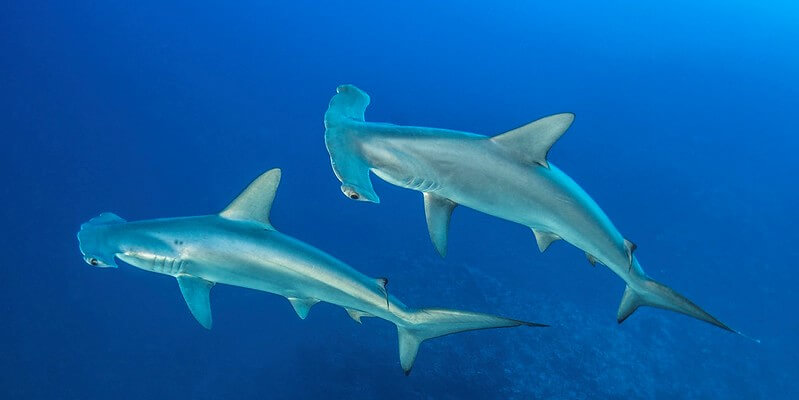Global shark fin trade
The global shark and ray (hereafter, ‘sharks’ for simplicity) fin trade appears to be on the rise again. In the last 20 years, volumes of fins exported peaked at around 15,000t in 2002, and began a gradual decline where exports bottomed at around 5,000t in 2013. However, since 2013, there appears to be a gradual increase in exported fins with the most recent estimates at around 11,000 t exported.
The global shark fin trade is a labyrinth of trade routes, loopholes, backdoors, re-exports and inconsistent reporting, making information difficult to access and assess. The challenges surrounding traceability of shark products are ongoing and incredibly complex. Suffice to say, whether the increase in fin trade is because of better reporting and regulation, because of increased demand, or both, there is one undeniable fact – sharks need our help, now.
Not all fins for sale are finned
Shark fins enter the market either by the finning or processing, two very different acts and an important distinction. Shark finning is cutting fins off a shark and dumping the body. In many countries, including Australia, this is illegal. In contrast, processing a shark is keeping the body and cutting it up into different products (i.e. flesh and fins).
The United Kingdom (UK) and Canada have announced they’ve stopped finning, and there’s a current movement to stop finning in the European Union (EU). Noting the distinction above, it’s not that the fin trade per se is stopped, but the barbaric act of finning is. Fins can still enter the market, legally, and the rule of ‘fins naturally attached’ (FNA) serves as world’s best practice as a practical means to curb (maybe stop?) the fin trade. More importantly, FNA prevents overfishing of threatened shark species.
‘Fins Naturally Attached’ – protection for sharks against finning and overfishing
FNA states that sharks have to be brought back to land in one piece with their fins on before processing. Without the FNA rule fishers can process sharks at sea by cutting fins and flesh into separate piles on the boat, so long as they’re in the right proportions (typically, this is set at 5% fins to flesh ratio).
But what if there’s not much room left on the boat, and a fisher catches some species whose fins are highly valuable–like the globally critically endangered (CE) scalloped hammerhead? Without a FNA rule in place, the fisher might choose to keep the highly valuable fins, throw away shark bodies, or throw away less valuable fins, to keep that ratio balanced while still having room on the boat. This is a practice called “high grading”, resulting in sharks being needlessly caught and their meat thrown away.
Once sharks are separated from their fins, it becomes very difficult to identify them and endangered species can end up in the mix. Species data is vital for fisheries managers to know if too many species are being caught, or even if protected sharks are being killed.
The UK and Canada have FNA in place for exports and imports of shark fins, a hugely commendable step forward. You can technically still trade fins but it’s going to be super expensive to export or import them because of the increased weight and volume required to ship whole bodies of sharks with fins attached. That cost is then absorbed by the importer and passed on to the consumer. So, as a business, do you really want to trade fins internationally? If so, the thinking is shark products will become traceable (you know which countries have FNA), premiums can be charged, and the money generated can fund continual improvements in the environmental performance of a fishery and the recovery of threatened sharks. Well, in theory at least.
Whichever way you cut it, that fact is FNA is fundamental to sustainable fisheries and a necessary step to help protect and recover our sharks.
Is the fin trade responsible for the global decline in sharks?
The short answer is ‘no’. Finning is certainly a key driver, but recent evaluation of global trade statistics shows shark meat, in terms of both volume and value, is driving the decline. While shark fins are generally more expensive p/kg than shark meat, the global trade in shark meat is worth just over USD 1 billion more than fins (USD 1.5 bill. vs 2.6 bill)
How many sharks are killed each year? Between 63-275 million and worse still, one in three (37%) species are threatened with extinction. The key fact about why sharks are in decline is because we’re fishing them faster than they can reproduce. Generally speaking, they’re about 10 years old when they reach maturity, have reproductive cycles of around two years, and give birth to around six pups. In the last 50 years, oceanic sharks and rays have declined by 70% because of overfishing.
Australia & the shark fin trade
What’s Australia’s role in the fin trade? Is shark finning happening? What are Australia’s trade statistics?
Although a relative blip on the legal shark fin export market, Australia is ranked in the top 20 (17/20) of the world’s importers. Based on converting reported fin weight to whole shark weight, our trade statistics reflect that, on average, Australia currently imports and exports a conservative maximum of 61,634 and 51,019 individual sharks, respectively, each year.
Irrespective of how much we export or import, we have an obligation as a well-resourced nation AND as a global shark biodiversity hotspot, to meet world’s best practise and implement FNA to stamp out finning. Unfortunately, Australia’s anti-finning rules are weak with gaping loopholes and inconsistencies.
At the time of writing, Western Australia (WA) is the only jurisdiction in Australia without FNA in any of its fisheries harvesting sharks. The Northern Territory (NT) has FNA in its major shark fishery (Offshore Net and Line Fishery), however lacks it in other fisheries where sharks are retained. Queensland only has FNA in its east coast fisheries, but lacks it in the Gulf of Carpentaria fisheries where there is no limit (i.e. quota) on the number of sharks that can be caught. All other fishery jurisdictions (New South Wales, Victoria, Tasmania, South Australia, Commonwealth) have FNA. The good-ish news is that WA is committed to having FNA by December 2022, the remaining NT fisheries are currently under reform and slated to have FNA, and the Gulf of Carpentaria is likewise currently under reform although there is no indication when FNA for all shark species will be in place.
FNA is fundamental. It prevents illegal finning and greatly assists with species identification – both of which prevent protected species entering the trade and help ensure other shark species’ populations are at healthy levels. Once Australia has FNA consistently applied across the country, the next step is for Australia to follow Canada, the UK and possibly the EU, in having FNA as a requirement for all imported and exported shark products.
When it comes to sharks, we are their biggest threat and their only hope. Become a shark champion today, to help us promote change through petitions.
References
- Winfield, K. Management of the Shark Fin Trade to and from Australia. (Environmental Defenders Office, 2021).
- Government to introduce world-leading ban on shark fin trade. GOV.UK https://www.gov.uk/government/news/government-to-introduce-world-leading-ban-on-shark-fin-trade.
- Feist, O. Europäische Bürgerinitiative: „Stop Finning – Stop the Trade“. STOP FINNING EU https://stop-finning-eu.org/.
- Simona, N. et al. The shark and ray meat network: a deep dive into a global affair. (2021).
- Worm, B. et al. Global catches, exploitation rates, and rebuilding options for sharks. Mar. Policy 40, 194–204 (2013).
- Kyne, P. M., Heupel, M. R., White, W. T. & Simpfendorfer, C. A. The Action Plan for Australian Sharks and Rays 2021. (2021).
- Heupel, M. R., Kyne, P. M., White, W. T. & Simpfendorfer, C. A. Shark Action Plan Policy Report. http://epubs.aims.gov.au//handle/11068/15377 (2019).
- Pacoureau, N. et al. Half a century of global decline in oceanic sharks and rays. Nature 589, 567–571 (2021).
- Dent, F. & Clarke, S. State of the global market for shark products. FAO Fish. Aquac. Tech. Pap. FAO Eng No 590 (2015).
- Salini, J. et al. Northern Australian sharks and rays: the sustainability of target and bycatch species, phase 2 | FRDC. https://www.frdc.com.au/project/2002-064.
- Leigh, G. M. Stock assessment of whaler and hammerhead sharks (Carcharhinidae and Sphyrnidae) in Queensland. 115 p. https://era.daf.qld.gov.au/id/eprint/5146/ (2015).






